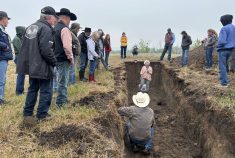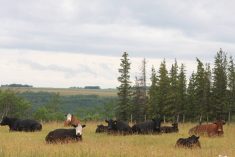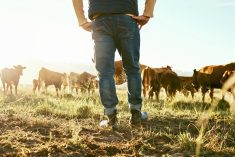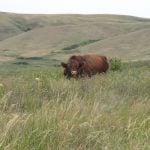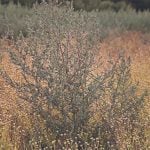Last column I outlined a brief history of the 1951- 52 foot-and-mouth outbreak around Regina, Sask. We haven’t had a foot-and-mouth outbreak in this country since, but it remains a global threat. The World Organization for Animal Health estimates that it affects 77 per cent of the global livestock population, circulating in Africa, the Middle East, Asia and parts of South America.
Today, the Canadian Cattle Association pegs the potential cost to Canada’s GDP of a widespread foot-and-mouth outbreak at $65 billion. But Janice Tranberg, president and CEO of the Alberta Cattle Feeders Association, thinks that estimate is likely low, as it was calculated years ago.
If foot-and-mouth reared its nasty head in Canada, hopefully we’d find it quickly enough to isolate it, says Tranberg. One of the nightmare scenarios would be if it hit Alberta’s feedlots, as 70 per cent of Canada’s fed cattle are in Alberta, and around 60 per cent of those animals are in southern Alberta, Tranberg says.
Read Also

The Canadian Cattle Association’s international advocacy efforts
Global ag policies affect Canadian food policy, so the Canadian Cattle Association participates in international and domestic forums
Foot-and-mouth also infects other cloven-hoofed animals, so it’s a risk to other livestock sectors and wildlife. Tranberg thinks that may be part of the reason it’s come to the forefront lately. With African swine fever, avian influenza and even COVID, we’ve realized that foot-and-mouth is “not such a far-off concept,” says Tranberg.
“It really could happen. And because it’s so multi-species, it could have such a big impact. And are we ready, I think, is the question. Are we prepared? And I’m not sure we are.”
The cattle feeders, along with the rest of the beef industry, have been asking for a foot-and-mouth vaccine bank for years. In theory, Canada has access to a North American vaccine bank, located in the U.S. However, there aren’t enough doses in that vaccine bank to handle outbreaks in both countries, and the Americans have established their own vaccine bank.
The National Cattlemen’s Beef Association, which is America’s national beef association, told the CCA “that it’s time for Canada to be independent of this reliance on their vaccine storage bank in the States,” Reg Schellenberg, at that time CCA president, told Karen Briere of the Western Producer last year. “We need to have something in-house.”
The industry is asking the federal government to fund a vaccine bank that would contain about 30 million doses, says Tranberg. The CCA’s website explains the proposed vaccine bank would comprise 2.5 million doses each of the 12 most prevalent foot-and-mouth concentrates. It would take about 14 weeks to produce a vaccine, according to the CCA’s website, so without a vaccine bank, we’re open to huge risks.
We wouldn’t want to routinely vaccinate livestock for foot-and-mouth, as doing so would create trade issues. But if the disease broke out in Canada, we could vaccinate susceptible animals within the outbreak area, hopefully halting the disease’s spread and hastening trade resumption. According to modelling by the Canadian Food Inspection Agency (CFIA), if foot-and-mouth emerged in a region with many livestock, we’d need between 1.9 million and 2.7 million doses. The CCA estimates the vaccine bank would cost $3.2 million annually.
“Considering the potential economic costs, it’s really quite a small ask,” says Tranberg, adding that the cattle feeders have added it to their budget submission. “If we could get that in place, it certainly would be a good first step.” Tranberg says that while it’s taken a while to raise awareness with the government on the vaccine bank, “we are hearing there could be some positive movement.” Speaking in late January, she added they hope to see something in the spring budget.
While the main thing is to convince the federal government to support a vaccine bank — something that Tranberg characterizes as a “reasonable and thoughtful investment” — she also thinks we need to keep working on a preparedness plan. How are we going to isolate foot-and-mouth if a case pops up in a certain area? “What are the procedures? Who do we have to pull together?”
When avian influenza struck, it was all hands-on-deck, Tranberg says, as it should be. “But how can we learn from that and how can we use that to make sure we’re not starting from square one all over again?”
There are groups planning for an outbreak. For example, Animal Health Canada is setting up a government-industry collaborative, and the Animal Health Emergency Management Project is working with CFIA on a plan. For the next step, Tranberg sees a need to pull everything into a cohesive plan.
“How are we going to work with our partners in the U.S.? Because borders to animal diseases … they’re pretty fluid. So we better be working with our partners there, as well.”
One of the challenges is that everyone has their hands full with diseases that are here, such as avian influenza. Tranberg acknowledges that we need to focus on those, “but we also have to look towards the future. If this happened, are we ready?”
Building awareness within the agricultural community is also important. If producers understand the risks, they’re going to be more cautious than someone who doesn’t quite understand the consequences of introducing the disease to Canada. If you’re planning to travel to a country that has foot-and-mouth disease, check the Verified Beef Production Plus blog for biosecurity tips and signs of foot-and-mouth.
No doubt there’s plenty of work to be done and some fund- ing needed to make sure we’re ready for a foot-and-mouth outbreak. But it’s also very positive that we haven’t had an outbreak in this country since 1952, says Tranberg. We have good systems in place, she says, and our food quality is top-notch.
“We monitor. We’re being careful. And the fact that we haven’t had a lot of these outbreaks in so long speaks to that.”




